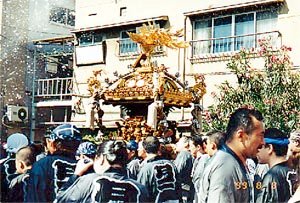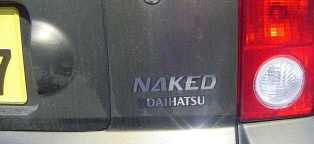Except for last weekend.
Once every 4 years for a three-day stint, this island loses its collective marbles.
Here is why, and what happens.
WHY?
It's summer, hot as hell inside and out, everyone is dragging. What better time to run around under the sun for 3 days?
WHAT HAPPENS
Imagine four long logs laid about 18" apart, with two long logs lashed across them. In the middle of this tic-tak-toe sports a nifty dark wood pavilion with a kind of Chinese style roof dripping flashy gold ornaments and topped with a rollicking bird (the Phoenix) with long bouncy golden tail feathers. The pavilion (Omikoshi) is a house for the local neighborhood deity (the kamisama).
Now imagine this flamboyant affair in various sizes, from pint-sized for kids to impressively huge. To start they sit placidly under little tents of red and white awnings, or reeded sides, that have blossomed overnight. Groups of the older guys lounge around doing something which I never really determined. Mainly, yak and drink beer and stare at the omikoshi. I yak a bit with them, but when they start pointing out the unmarried guy, I decide to move on.
Friday night
I ride my humble single speed shopping bike to where the local big Shinto shrine (the "jinja") adorns the northern end of the island, complete with large torii gates, big shrine for priests and general kamisama supplicating. It's the spiritual center of the island. New fact for me: There are numerous other lesser jinja tucked away throughout this island, all under the protection of this main jinja's powerful kamisama. Sort of a spiritual hierarchy.
However, tonight, it's the tailgate party for the weekend. The food and entertainment stalls are out, spreading along the little bridge across the local canal near the jinja. Groups of people are strolling about in cool yukata, the summer cotton lightweight kimono-style garb of choice. Everyone is hanging out on under the dim lights spilling out from the open kitchen doors, it's quite a party. How delightful it is to see all the parts of Japan operating under their normal, natural conditions. It's a scene from the past, still with us.
Saturday morning
What's this? Huge blue plastic barrels have appeared along all the streets. The paper lanterns that have been up for days provide picturesque adornment for the many wooden homes. Another postcard picture. Hey, what's that racket? Yes, the big mikoshi have launched from their sites upon the shoulders of a bunch of kids.
Take this Theme and Repeat 50 times.
Various cheerleaders abound. Other roles keeping the festivities rolling along are:
Dance Dressage white (to start) tabi socks, cotton tights, cotton top in traditional summer patterns, hanten (the happi coat) and around the head, a twisted towel.

Omikoshi Jam and Rave. Photo by Etsuko Shioda
Where do I buy this stuff? The local stores. Now! For 3 days only! Get your truly peasant outfit right here. Good for summer wear forever! The hanten turns out to have the kanji symbol of the Big Shrine on the back. On the front is the neighborhood address. Mine says "Tsukishima, 4 moons" which is a word play on "4 neighborhoods". So, I'm part of the neighborhood scene now.
Saturday night
The best block party of all time.
I meet a Japanese co-worker at the local MacDonalds. Never realized before, but this must be where the local foreign population hangs out, judging by the numbers. I'm in the peasant gear, topped (bottomed?) by my wood geta, feeling like a flaming idiot until I realize what other people are wearing. Guys have been running around town nearly naked, lots of people dressed like rice farmers, even many foreigners have been in summer splendor. So, I'm fitting right in. My friend Noriko is resplendent in her new yellow-green yukata from Mitsukoshi (very expensive Ginza department store), broad obi, and wooden geta. A far cry from her Western suit. We join the denser crowds around the same area I perused last night solo. I'm busy eating an entire fish on a stick and it's quite yummy. There will be a photo of my holding the stick with it's head only remaining, mouth agape. We talk about living here in Tsukishima, how to meet people, why it's such a special area. Many parts of Tokyo are rather forbidding, but this area has character which seems to be passing down successfully to the next generations. It's tradition, and really cool.
Sunday morning: 6:00 am.
The big drums start tuning up. I bike to pick up Noriko, who is back into yellow jeans. She perches on the back of the bike and we careen back to the Big Jinja site. This time, it's pretty much the locals only. The biggest mikoshi so far is squatting in the sandy courtyard before the main temple door. The headman is out, in ancient costume. Various mumbling goes on. It's a solemn moment as the kamisama spirit leaves the inner recesses of the jinja and comes into the Omikoshi and says "OK! Let's go for a ride! Show me the joint!" Then, a bunch of hanten'ed men throw paper airplanes onto the Big Mikoshi. The airplanes have cash inside. Then they hoist it and run riot around the courtyard. Which is very small. 6:00am.
My job: not get squashed. Eventually it breaks free of the courtyard and proceeds up the narrow walkway, up the ramp to the riverbank and onto a waiting barge, and proceeds on a stately tour around the entire island. With long banners waving, everyone in long yukata, and band playing (sitting on their knees playing the old songs of long ago), it's quite a Blast from the Past. Noriko and I walk back along the river's grassy edge, beneath clouds of very large yet benign dragonflies. It's quiet, for the moment.
Sunday afternoon
Those buckets and barrels of water along the streets? Just what is going on here?
Throughout Saturday and Sunday I've done this cycle: work on my webpage in blessed air-cond'ed comfort until I hear the thunderous rioting outside somewhere. Haul my blue peasant gear off the drying pole outside and don the duds. Slip on the slippers. Leap on the bike and track down the sound. Park. Walk my round-eyed self into the crowd. Wow, look at the expressions on the faces of the Omikoshi haulers. Are they in pain? Heave-ho, heave-ho, walk over here, stumble over there. Hey, who's in charge here? Stop, start, left, right, whatever! Everyone is yelling and some are screaming. Hoi! Hoi! Hoi! It's Hot! Hot! Hot!
Then, relief! Yes, those usually placid grannies, responsible shop keepers, and people generally the soul of low-key good behavior, and throwing buckets of water over everyone and each other like there is no tomorrow. Every water hose in sight is going full blast. For someone from water-poverty California, where some summers you just can't wash your car without risking severe guilt, this is ecstatic. I'm soaking wet.
Guess what, after three days of being soaked down, those all wood mikoshi are seriously waterlogged. I discovered this fact thusly:
A week later my shoulder still feels like someone beat it with a baseball bat.
I buy a pair of cloth tabi from my favorite shoe store, a tatami matted room with sliding doors to the sidewalk. The owner and his family are literally sprawled out on the tatami, watching the parade go buy, and they invite to share a brewski and riceballs and tough, dried out flattened fish. Ah, the traditions of summer. One woman gamely goes for using English, and does pretty well. She has spent a summer at Oxford. Now, she's selling shoes and socks with Mom and Day. The smells of straw from the mat, strong cedar from the wood beams, and wet cotton from my feet. Beer. Rice. Sun. Water. All your friends coming by acting like lunatics. Not the worst life I ever saw.
Sunday finale
One last omikoshi cruise. The riot is now taking place again in my own neighborhood, which is just south of the main shopping district, in an area that blends into the large warehouses and shipping harbors that offload millions of yen worth of frozen fish daily, bound for Tsukishima's world famous fish market just across the river.
I'm noticing something about this crowd. A lot of veeeerrrrry large and exquisite tattoos on display. Big dragons, samurai warriors, floating clouds, the koi/goldfish/carp. On men and women. Hmmm. Do I live in the middle of a big yakusa gang, probably affiliated with the Fish Trade? I think so! For the first time, as I follow along, I feel glances my way that are not exactly warm and welcoming. Is it my imagination? Is it just the heat, my own developing sunburn, my aching shoulder but I'm suddenly feeling very pushed around and crowded. The sun is setting. The water's getting a big chilly. Lots of beefy young guys are getting very rowdy under the omikoshi. There are more of the usually friendly local police in blue, short sleeved summer CopWear. As we careen into the warehousing area, over the last canal bridge, an actual fistfight breaks out in front of me, the first I've ever seen here. One particularly large guy in bright orange Hanten, jumps over the railing and with a hard shove to my shoulder, jumps into the melee. It's confusing, but soon whoever was upset is pulled apart, the combatant crowds shove and push, meanwhile the chanting is going on and there's more water. Then, the dispute evaporates. I've seen a lot of tattoos like a necklace of pearls around a lot of necks. The Omikoshi parks, the food'n'beer comes out. It's enough and I walk back through the milling pack of red faces and necks and thighs, the unknown people, the unspoken associations.
Monday morning
Dressed for work, I take one last bike cruise just a block away. There will be a late morning final Omikoshi, which I will not see, returning a glorious gold and black eight-sided Omikoshi from another hidden jinja to be reunited with the main jinja to the North. A few hanten men are sitting around looking at it. One man is straightening up the bamboo shafts and hanging the final twisted straw cords with white paper lightening symbols around it. The jinja head guy is in full regalia and towering head gear. At last, all is quiet on the Omikoshi Front.


